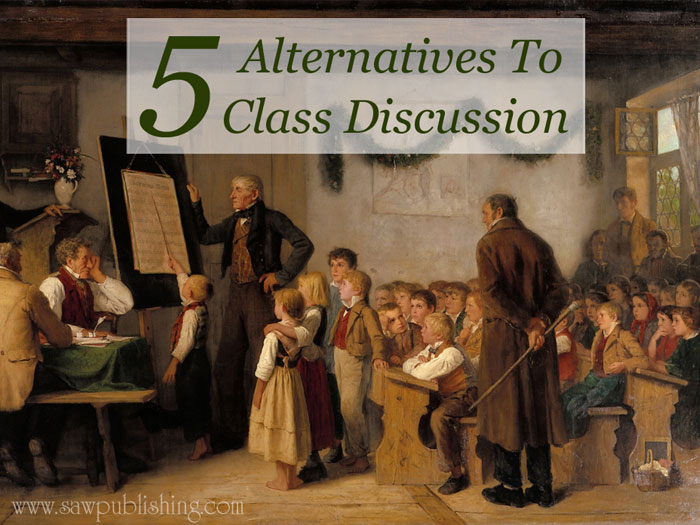How to Teach Your Students to Think
Timeless Tips from Educators of the Past is a companion series to our Timeless Tips from Homemakers of the Past – highlighting useful and thought provoking advice from the generations of educators who have gone before us. Our goal at Sheep Among Wolves is to provide a forum for Good and Great literature, and to help you in your quest for godly, high-quality resources. It is our hope that these Timeless Tips will be an aid and encouragement to you as you strive to follow the example of Deuteronomy 6 and diligently teach your children the words of the Lord.
 Is thinking something we actually need to teach our students? At first, it sounded to me like a strange idea. Isn’t learning all about thinking? Why do you need to teach that?
Is thinking something we actually need to teach our students? At first, it sounded to me like a strange idea. Isn’t learning all about thinking? Why do you need to teach that?
My co-author emailed me the outline for my next blog post. I looked at the title, and raised my eyebrows. Was it just a catchy headline, or did she really imagine that thinking was a school subject? You know, the three T’s of education—Teaching, Textbooks and—Thinking?
But when I finally looked at the outline, and understood the point being made, I totally agreed with her. Thinking is something we need to teach our students.
And in fact, it’s the most important thing we ever can teach them. Because unless our students learn to think, they will never really learn anything at all.
What is Our Aim in Teaching?
In order to achieve our aim in teaching, we need to understand that aim. The great aim of education is for pupils to internalize knowledge. As Christians, it is even more important that our students embrace (or internalize) the fear of the Lord.
Losing track of either of these aims will mean that ultimately we find ourselves off course. The famous example of the spokes on a wheel reminds us that a small deviation at the starting-point makes an immense change in our destination. At the centre of the wheel, each spoke is close to the others, but by the time they have reached the rim they are widely separated.
It’s easy to lose track of our real aims in teaching, and find ourselves focusing on simply completing exercises rather than ensuring our pupils make knowledge and the fear of God their own.
In every aspect of our homeschooling we must remember that what our children learn is of far more importance than what they are taught.
How to Teach Your Students to Think
Brainerd Kellogg and Alonzo Reed in their 19th century textbook, Graded Lessons in English, instructed: “The teacher is recommended, before assigning any [i.e. the first] lesson, to occupy the time of at least two or three recitations, in talking with his pupils about language, always remembering that, in order to secure the interest of his class, he must allow his pupils to take an active part in the exercise.”
They go on to say:
“The teacher should guide the thought of his class; but, if he attempt to do all the talking, he will find, when he concludes, that he has been left to do all the thinking.” (Original emphasis.)
What a powerful statement! In this comment, Kellogg and Reed have pinpointed the key to training students to think—first, get those students to talk.
How to Get Your Students to Talk
Of course, simply answering questions is hardly the beneficial discussion Kellogg and Reed are getting at. In order to derive success, we need to encourage our students not to “find the right answer” but to grapple with and own the subject. This transition can take a little time. Students need to be taught how to discuss. But the more we encourage discussion, the more we encourage thought.
 A few key ways to lead away from answering questions and into true discussion are:
A few key ways to lead away from answering questions and into true discussion are:
- Ask opinion questions, not just fact questions. Facts are great, but pupils are much more likely to have a conversation about something which involves opinions. It also gives the teacher an excellent opportunity to continue the conversation by asking, “Why do you hold that opinion?”
- Take time for spontaneous discussions. If a pupil has a reasonable question or comment, don’t hesitate to pause the lesson and talk about it. Actually wrestling with the content of a lesson usually means your pupils are really learning!
- Carry discussions across subjects. If you have just been studying foreshadowing in literature, point out the foreshadowing that occurs in your history, or biography, or read-aloud time. Carrying information between subjects helps students to think and apply what they learn beyond the context of the textbook.
- Be ready to listen. No, listening to what your child learned in their assigned reading, at four-thirty in the afternoon while you’re trying to stir the spaghetti and occupy a teething nine-month-old at the same time, is not all that convenient! But try to take a genuine interest in what is interesting your student. Talking—and thinking—out of school hours is even more valuable than during class.
- Really, really encourage sharing with the whole family. This is an area where parents can do so much to help their kids. You can be pretty sure your student has thought about—and internalized—information when they share it at the dinner table! The habit of discussing the day’s interesting tidbits does so much for a child’s general education.
How to teach your students to think is really how to teach them to discuss. Truly meaningful discussions are worth far more than hours upon hours of study that is neither internalized nor remembered. (This is essentially the same principle as Plato introduces to us under the name of Meno’s Paradox.)
Keep Your Aim in View
Perhaps I wouldn’t have raised my eyebrows at the title sent me by my co-author, if I hadn’t been taking her point for granted. Thinking is of course essential to learning, and so perhaps I’d lost track of its necessity in its self-evidence.
But taking our aim for granted is just what we can’t do as teachers. We need to be constantly mindful of the point of what we’re doing, and not forget that reading textbooks and answering questions are the means not the end.
It is important to teach your students to think, and equally important not to sacrifice the opportunity for meaningful thought to the desire to “cover ground.”
Because, in the end, if we engage our students in discussions that internalize knowledge, we’ll have covered far more ground in reality, than any number of lessons half-heard and never known.
Unsure how homeschoolers can have a “class discussion?” Follow this link to discover tips and alternatives for class discussions in homeschooling:
You might also enjoy:

Isaac Watts’ four reasons to teach your children hymns challenge you to make use of a powerful tool for training the next generation.

Unto the Hills Around, by John Campbell, captures the comfort and beauty of Psalm 121 in a faithful meterization which is easily memorized and sung.

Reading aloud isn’t hard, and it has incredible benefits for the entire family. Find a godly, worthwhile book, and start today!

